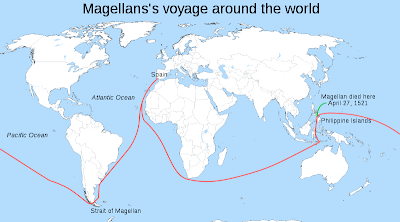 Magellan reaches (and names!) the Pacific Ocean (1520)
Magellan reaches (and names!) the Pacific Ocean (1520)
n
nIn 1519 Ferdinand Magellan, a Portuguese explorer, launched an expedition that ended up being the first to sail around the world. Although he himself was killed before the expedition returned to Spain in 1522 and 1525 (in two different ships), Magellan had in an earlier voyage sailed eastward from Europe as far as the Malay Peninsula; between the two voyages, he could be said to have sailed all around the world.
n
On this date in 1520, Magellan’s was the first European expedition to reach the Pacific Ocean through straits at the southern tip of South America. Magellan named the Pacific Ocean “peaceful” because, when he first entered the waters from the treacherous straits, the ocean seemed still and calm. Magellan also lived long enough to be credited with leading the first European expedition to cross the Pacific. He died in the Philippines in 1521.
nSo…What’s a “strait”?
A strait is a narrow channel of water that connects two larger bodies of water. Note that the entire idea of a strait is that ships can navigate through it, so a really shallow bit of water between two land masses would not be called a strait. Magellan did not, of course, have a map of much of the area he explored. When he carefully sailed through the Strait of Magellan—a journey that took almost a month—he was looking for a safe passage through unknown waters.

n
This map was created by Battista Agnese in 1544, probably based on the descriptions and maps made by survivors of Magellan’s expedition. Notice that there is no clear indication of where the land masses end—because the explorers didn’t know. Were the cliffs and lands they saw parts of continents, peninsulas, islands?
n
This modern map shows the reality of the situation. We are lucky enough to have explored the world pretty thoroughly, not just by land and sea, but also by air. We even have satellite images!
n
nMore maps: Looking at old maps of the Strait of Magellan, we can see a progression of knowledge gained from further exploration.
n
n
Match these famous straits to their descriptions:
1. Strait of Gibraltar
2. Bering Strait
n 3. Dire Straits
A. between Alaska and Siberia, connecting the Arctic and Pacific Oceans
nB. between Spain and Africa, connecting the Atlantic and the Mediterranean
nC. British rock band between stadium rock and punk rock, connecting the 70s to the 90s
n
n
n
nANSWERS: 1.B 2.A 3.C
n
Names…names…names…
All through history, names of things and creatures and places and even people change, which makes names very tricky things. One reason for this trickiness is that there are a lot of different languages in the world, so different peoples have different names for the same food, say, or animal.
Or ocean! We can be downright certain, when we hear that Ferdinand Magellan named the Pacific Ocean in 1520, that many, many other names for the same ocean existed, and continue to exist, in the many different native cultures and languages of the world. For example, Japanese used to call the Pacific Ocean Tokai, which means “East Sea” (because the Pacific borders the eastern coast of Japan, of course), and the Maori natives of New Zealand called it Te Moana-nui-a-Kiwa, or “the great sea of Kiwa.”
n
nMagellan’s name is attached to the strait that he used to cross from the Atlantic to the Pacific, but he himself gave it another name: All Saint’s Straits. This name commemorated the fact that the expedition entered the strait on November 1, All Saints’ Day.
Magellan’s name is also given to a kind of penguin (the Magellanic Penguin) that lives in South America and to two small, irregular galaxies (the Large and Small Magellanic Clouds) that can be seen from the Southern Hemisphere. More recently, the Magellan probe mapped the planet Venus in the 1990s, and there is a GPS unit named Magellan.
Finally, we know Magellan (and honor him by naming things) by the English version of his name rather than his actual name. He was born Fernão de Magalhães, in Portugal, and when he renounced Portugal and became a Spaniard, he became Hernando de Magallanes.
